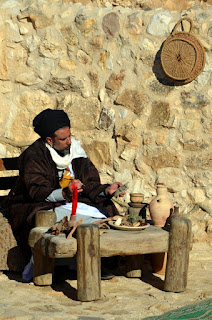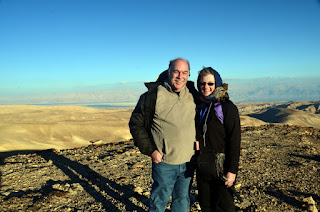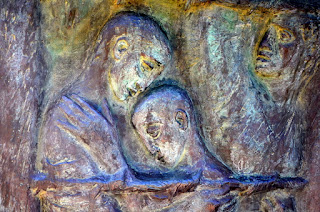. . . . . . . . . Alan and Joyce were given a chance to return to Israel for a 'reunion' tour, led by singer/song writer/author, Michael Card in December 2016 into early 2017. We will be touring Israel with the theme of pursuing 'hesed' through the ages. Michael Card defines hesed as "When the person from whom I have a right to expect nothing, gives me everything.”
Saturday, December 31, 2016
Friday, December 30, 2016
Hesed in the Desert - December 31
Abdullam
The first stop of the day involved another hike. David told us that the length was about the same as yesterday, but that this one would be steeper. A couple of our folks decided that a time of meditation on the bus would work well for them. After a pit stop along the way we came to a small moshav, where David warned us that we might have a problem with the gate being closed, since it was Shabbat. Thankfully, the gate was half open, so we were able to help it open fully, and we were good to go.
Kamal did an amazing job threading the bus down some pretty small roads, but apparently even he has his limits. As we deboarded, the path up the hill was in front of us. This road was not nearly as smooth as the one to the Scrolls of Fire, and David was true to this word. This one was steeper. Some of us took several chances along the way to stop to 'allow the others to catch up with us.'
As we went up...and up...and up, we wound around the hill and past some small trees, outcropping, and green grass. Eventually we came to an area near the top where we made our way to an area that had several caves. We also saw the remains of an old sheep fold.

 We know that this is the area where David and 400 of his men hid from Saul's army because there was an Arab village of the same name up until the mid-1900's here. It was pretty amazing to stand at the main cave in the area, knowing what happened here about 3000 years ago. We has a brief teaching time and we spent several minutes exploring before reluctantly heading back down to the bus. But this time it was because of the experience of being there and not because of dread of negotiating the path.
We know that this is the area where David and 400 of his men hid from Saul's army because there was an Arab village of the same name up until the mid-1900's here. It was pretty amazing to stand at the main cave in the area, knowing what happened here about 3000 years ago. We has a brief teaching time and we spent several minutes exploring before reluctantly heading back down to the bus. But this time it was because of the experience of being there and not because of dread of negotiating the path. 
 We made our way down to the community of Arad for a specially arranged lunch at a pub. We were there on Shabbat, remember, which means that in the Jewish communities, most places are closed. We had a fantastic lunch, with most of us having hamburgers, of all things, but with an Israeli flair. Joyce and I ordered the small burgers, 220 grams, vs. 330 grams. That turned out to be about a 1/2 pound burger! They were prepared nicely, with cucumbers, onions, olives, aeoli, tomato, and either a salad or Muzo potatoes.
We made our way down to the community of Arad for a specially arranged lunch at a pub. We were there on Shabbat, remember, which means that in the Jewish communities, most places are closed. We had a fantastic lunch, with most of us having hamburgers, of all things, but with an Israeli flair. Joyce and I ordered the small burgers, 220 grams, vs. 330 grams. That turned out to be about a 1/2 pound burger! They were prepared nicely, with cucumbers, onions, olives, aeoli, tomato, and either a salad or Muzo potatoes.Arad
After eating lunch in the
modern city of Arad, we traveled about 10 miles to the ruins of the
ancient city of Arad. The city was located at the edge of the Judean
foot hills and the Negev desert. This is a fascinating site that was
inhabited several times.
 You can see the ruins of a large ancient
Canaanite city that dates to around 2500 BCE. This city shows
evidence of centralized government with the ruins of a “suburban”
house.
You can see the ruins of a large ancient
Canaanite city that dates to around 2500 BCE. This city shows
evidence of centralized government with the ruins of a “suburban”
house.
The city appears to have been inhabited for many years and then ceased to exist for unknown reasons. Also on the site in the highest location is a fort that was built by King David as he was solidifying the border of the southern kingdom. The enemy to the south was the Philistines. Without a strong fort for protection there was also the danger of desert maunders.
Within the fort there is evidence of both worship of Yahweh as God commanded as well as the dual worship of Yahweh and the pagan goddess Asherah. The alter is constructed of mud bricks and field stones that have not been cut by human hands as God commanded to Moses.
In the Holy of Holies, there is evidence of the dual worship. Seeing the alter and the Holy of Holies really made the Bible come alive to Joyce as she stood in front of the evidence that God’s people followed His commands is some ways but fell so short in others. We have the benefit of history to show us the pain people endured and still endure as a result of straying from God’s plan for the Promised Land. This gives me new understanding of the importance of seeking God’s perfect plan and a new appreciation and love for the God we serve who truly wants the best for all His precious people.
 You can see the ruins of a large ancient
Canaanite city that dates to around 2500 BCE. This city shows
evidence of centralized government with the ruins of a “suburban”
house.
You can see the ruins of a large ancient
Canaanite city that dates to around 2500 BCE. This city shows
evidence of centralized government with the ruins of a “suburban”
house.The city appears to have been inhabited for many years and then ceased to exist for unknown reasons. Also on the site in the highest location is a fort that was built by King David as he was solidifying the border of the southern kingdom. The enemy to the south was the Philistines. Without a strong fort for protection there was also the danger of desert maunders.
Within the fort there is evidence of both worship of Yahweh as God commanded as well as the dual worship of Yahweh and the pagan goddess Asherah. The alter is constructed of mud bricks and field stones that have not been cut by human hands as God commanded to Moses.
In the Holy of Holies, there is evidence of the dual worship. Seeing the alter and the Holy of Holies really made the Bible come alive to Joyce as she stood in front of the evidence that God’s people followed His commands is some ways but fell so short in others. We have the benefit of history to show us the pain people endured and still endure as a result of straying from God’s plan for the Promised Land. This gives me new understanding of the importance of seeking God’s perfect plan and a new appreciation and love for the God we serve who truly wants the best for all His precious people.
Judean/Negev Desert Overlook –
Following our time at Tell Arad, we drove through modern Arad to an
overlook of the Judean and Negev deserts as well as the salt flats of
the Dead Sea.
We walked about a quarter mile to the overlook in a pretty strong, cool wind. Michael Card commented that when God makes a wilderness, it is beautiful, which was certainly true as we looked out over the grayish brown hills, turning a golden color in the late afternoon sun, the brilliant blue of the Dead Sea and the muted distance hills of Moab in Jordan. We could also see where Sodom & Gomorrah were located.
 We discussed 1 Samuel 25. I won’t tell the
story as you can read it – I’ll share some of the thoughts of our
discussion. David, our guide, defined fool, as Nabal is called, as a
person who has forgotten who he is in the sight of God. Soon to be
King David was in the right to ask for payment for his protection of
Nabal’s men and animals. Abigail’s request to David is that what
he is about to do, even though he has a right to do it, is not in his
nature or his best interest. David was securing his borders, getting
rid of enemies, like the Philistines and making important alliances.
Considering customs in this region, what he was about to do would
have created blood feuds that would most likely lasted for
generations. David listened, God handled the situation and David
praised God. It was good to reflect on times in our lives when waiting on God
to handle a situation in His perfect way and timing has produced
blessing and thankfulness.
We discussed 1 Samuel 25. I won’t tell the
story as you can read it – I’ll share some of the thoughts of our
discussion. David, our guide, defined fool, as Nabal is called, as a
person who has forgotten who he is in the sight of God. Soon to be
King David was in the right to ask for payment for his protection of
Nabal’s men and animals. Abigail’s request to David is that what
he is about to do, even though he has a right to do it, is not in his
nature or his best interest. David was securing his borders, getting
rid of enemies, like the Philistines and making important alliances.
Considering customs in this region, what he was about to do would
have created blood feuds that would most likely lasted for
generations. David listened, God handled the situation and David
praised God. It was good to reflect on times in our lives when waiting on God
to handle a situation in His perfect way and timing has produced
blessing and thankfulness.
We walked about a quarter mile to the overlook in a pretty strong, cool wind. Michael Card commented that when God makes a wilderness, it is beautiful, which was certainly true as we looked out over the grayish brown hills, turning a golden color in the late afternoon sun, the brilliant blue of the Dead Sea and the muted distance hills of Moab in Jordan. We could also see where Sodom & Gomorrah were located.
 We discussed 1 Samuel 25. I won’t tell the
story as you can read it – I’ll share some of the thoughts of our
discussion. David, our guide, defined fool, as Nabal is called, as a
person who has forgotten who he is in the sight of God. Soon to be
King David was in the right to ask for payment for his protection of
Nabal’s men and animals. Abigail’s request to David is that what
he is about to do, even though he has a right to do it, is not in his
nature or his best interest. David was securing his borders, getting
rid of enemies, like the Philistines and making important alliances.
Considering customs in this region, what he was about to do would
have created blood feuds that would most likely lasted for
generations. David listened, God handled the situation and David
praised God. It was good to reflect on times in our lives when waiting on God
to handle a situation in His perfect way and timing has produced
blessing and thankfulness.
We discussed 1 Samuel 25. I won’t tell the
story as you can read it – I’ll share some of the thoughts of our
discussion. David, our guide, defined fool, as Nabal is called, as a
person who has forgotten who he is in the sight of God. Soon to be
King David was in the right to ask for payment for his protection of
Nabal’s men and animals. Abigail’s request to David is that what
he is about to do, even though he has a right to do it, is not in his
nature or his best interest. David was securing his borders, getting
rid of enemies, like the Philistines and making important alliances.
Considering customs in this region, what he was about to do would
have created blood feuds that would most likely lasted for
generations. David listened, God handled the situation and David
praised God. It was good to reflect on times in our lives when waiting on God
to handle a situation in His perfect way and timing has produced
blessing and thankfulness.
Michael Card read for Deuteronomy,
Psalm 106 and Jeremiah. He shared an insight a friend had given him
which he called the Desert ideal – Sonship and daughterhood is
established in the wilderness. Much food for thought today.
 We left the wilderness and drove for 1
½ hours to Mitzpe Ramon, enjoying a beautiful sunset over the desert
hill. Unfortunately we were seated on the wrong side of the bus to
get many really good pictures. We enjoyed another delicious buffet dinner,
which we were surprised to see included sausage, and concluded our
day.
We left the wilderness and drove for 1
½ hours to Mitzpe Ramon, enjoying a beautiful sunset over the desert
hill. Unfortunately we were seated on the wrong side of the bus to
get many really good pictures. We enjoyed another delicious buffet dinner,
which we were surprised to see included sausage, and concluded our
day.Scrolls of Fire
 We visited an impressive bronze monument dedicated to Jewish Holocaust survivors on a high hill in the Judean hill country. An inscription near the monument reads:
We visited an impressive bronze monument dedicated to Jewish Holocaust survivors on a high hill in the Judean hill country. An inscription near the monument reads:FOR THE MARTYRS
Mutely the stone speaks
of the martyrdom of the six million
whose body drifted as smoke
through the air
Silence-Silence-Silence
You who were born afterwards
remember the men, women, children
who became martyrs
in a time of violence
Lower your heads in humility
Subscribe to:
Comments (Atom)














































